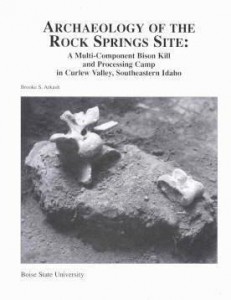Archaeology of the Rock Springs Site
 Monographs in Archaeology, Volume 1
Monographs in Archaeology, Volume 1
by Brooke S. Arkush with contributions by Danny N. Walker, Patricia A. Dean, and Shawn McVey
ISBN: 0-9639749-7-1 (2002)
185 pp.
Cost $15.95
Introduction
Between 1994 and 1997, the Weber State University Archaeological Field School spent a total of nine weeks excavating the Rock Springs site (10-OA-210), a multi-component prehistoric bison kill and processing camp situated in the extreme northwestern portion of the Curlew Valley, Oneida County, southeastern Idaho. Our investigations of these 1.5 m deep cultural deposits revealed the presence of at least seven distinct occupational episodes dating between approximately A.D. 1000 and 1800, which indicate that the Rock Springs locality served as a traditional, long-term bison hunting area for local Native peoples. Given the natural topography of the area, it seems likely that the predominant communal hunting strategy was to drive bison into natural traps or bottlenecks such as that formed by two converging finger ridges at the head of Rock Creek. With the exception of previous excavations at Malad Hill (Swanson and Dayley 1968), Bissell Springs (Franzen 1977), and Weston Canyon Rockshelter (Miller 1972; Arkush 1999a), and small cultural resource management-related surveys, this region has received little or no attention from professional archaeologist, and the prehistoric record therein is only superficially understood. The Rock Springs project has improved our understanding of regional prehistoric subsistence systems and settlement practices, and its presence suggests that additional bison drive and butchering sites exist within the greater Curlew Valley region.
Rock Springs is located in rolling hills east of the Sublette mountains where water from the springs flows eastward between two finger ridges into a narrow drainage about two meters deep. Site 10-OA-210 occurs on the southern stream terrace immediately east of the ridges; bison apparently were driven through the natural funnel formed by the finger ridges, forced into the creek bed, dispatched in this confined area, and then butchered and extensively processed along the stream terrace. The Rock Springs site lies within the extreme northern Bonneville Basin–Rock Creek flows southward into Deep Creek which in turn flows into the northwestern arm of Great Salt Lake near Locomotive Springs–and is somewhat unique because it represents one of the few known prehistoric bison kill and/or processing sites within, or adjacent to, the northeastern Great Basin. As such, it is an extremely interesting and important cultural resource. Intensive excavations at 10-OA-210 were conducted in order to improve our understanding of communal late prehistoric bison procurement in northern Utah and southern Idaho, especially in regard to the frequency, seasonality, technological organization, and butchering practices associated with an important, but heretofore poorly documented, aboriginal activity within this region.